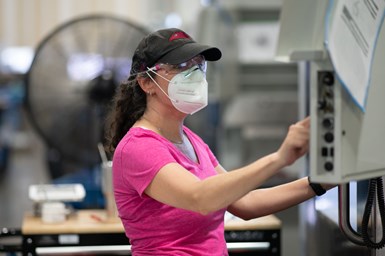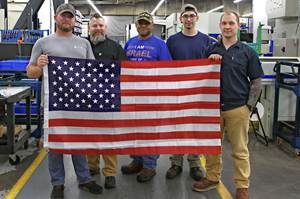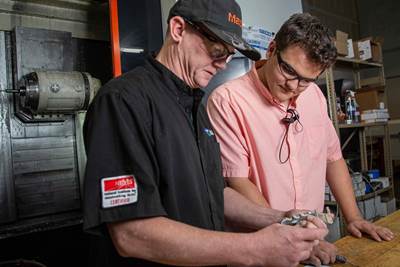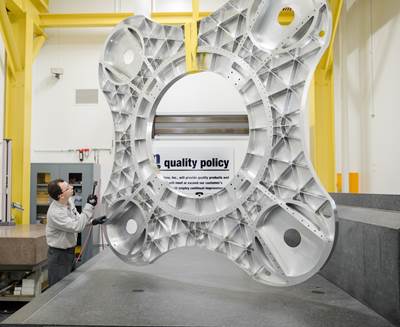Driving Continuous Improvement with a Quality-First Mindset
A continuous improvement, quality-first mindset can help shops improve upon key metrics — across all departments.
Share




As manufacturing returns to North America, machine shops are eager to capture a larger share of the market. But delivering high-quality parts is no longer enough to set a shop apart.
Advances in technology and equipment have made it easier than ever for machine shops to deliver tight tolerances and complex geometries. In order to compete, shops need to do more than just produce exceptional parts. They need a quality-first mindset that guides every part of their business, their service and their relationship with customers.
Growing While Moving
Relocating a large-scale machine shop like Plethora across the country is no easy task. But in 2019, we relocated our manufacturing operations from San Francisco to a 57,000-square-foot facility in Marietta, Georgia.
The move affected all aspects of our business. We experienced capacity constraints while our mills were in transit. We needed to establish new vendor relationships in Georgia. We needed to expand our workforce, hiring machinists and other skilled professionals. We had to expand our sales team to cover our new market. Through it all, though, we needed to maintain our reputation for high-quality parts.
We were able to come through the move stronger, and build on that in 2020, due to our quality-first mindset. Applying quality standards across all facets of our business, and holding our team accountable to those standards, has made us a stronger company today. Our customers noticed too, as we have expanded upon existing customer relationships while adding dozens of new customers.
A quality-first mindset comes down to measuring, testing and improving every step of the way. If it can be measured, then quality is key. Many parts of our business are easy to measure, such as revenue, total machining hours and number of orders. But there are some things that we may take for granted and fail to measure. Identifying those opportunities, establishing baselines and working to improve every single one of them will pay dividends in the long run.
Transparency with Employees

Transparency with employees is one step to ensure a quality-first mindset. Photo credit: Plethora
To bring a quality-first mindset to every part of your business, your entire team must take the journey together.
When quality becomes something the entire company rallies around and celebrates, great things happen. Managers lead by example, acknowledging areas where they can do better. Employees grow more inspired to improve their own performance and contribute ideas for achieving better results throughout every part of the organization.
Reaching that level of enthusiasm for quality requires transparency and a delicate touch. Introducing a quality policy shouldn’t be about calling people out for doing something wrong, but about what everyone can do to help serve customers better. The best organizations — the types of professional teams we all aspire to be like — have a quality policy to drive ongoing improvement.
Emphasizing Business-Wide Quality
Every aspect of a business can be measured, tested and improved. Assigning quality-driven initiatives across teams helps keep everyone involved and motivated.
Sales can measure the number of customers quoting parts each week or month, as well as the number of new customers or prospective customers each month or quarter. Invoicing can track the percentage of accounts receivable paid in 30 days, as well as the total number of outstanding accounts receivable. Sourcing can investigate the percent of booked orders where material was on-hand within 24 hours. Beyond cycle times and parts produced, manufacturing can also measure scrap material as a percentage of total material used.
Focusing on the Customer
One area Plethora has seen tremendous gains over the past few years is with our sales team.
We had to think long and hard about who we serve and what they expect from us. Many of our customers are product designers and manufacturing engineers — experienced professionals with a great deal of technical expertise. We knew that, in order to best serve these customers, we had to speak their language. Even the most successful, seasoned sales representatives risked losing credibility if they couldn’t confidently speak about details like approach angles, chamfers and workholding options.
We began hiring specifically for technical expertise. We found teaching these account reps how to be effective salespeople was far easier than teaching experienced sales professionals the nuances of manufacturing and machining.
So far, we’re happy with the results, and our customers are too. We’re able to have deeper conversations about their entire project and assembly, not just the individual parts they ask us to bid. This has led to more quotes and more orders. We can also better hold our sales team accountable to metrics that truly drive our business — parts quoted per user per month, parts quoted by account per month and users quoting by account per month.
This data helps us support our sales team. We can quickly step in to help when a rep’s activity is down, coach reps who need help working an account or assign more accounts to reps who need them. In turn, our sales team is able to better support our customers, helping us all achieve better results.
Little Things Make Big Differences
Even seemingly small details can benefit from a quality-first mindset.
Since opening in Marietta, we’ve focused on reducing waste and getting more value from our material. So far, we’ve not only lowered our scrap by eight percent, but are now selling a greater portion of it back to a local recycling company at a higher rate.
Applying the quality-first mindset to scrap helped us lower our material costs, create less waste and get more value out of the scrap we do create. By making parts more efficiently, we’re able to complete projects with less material — a real benefit that our customers notice.
Seek Customer Feedback
One of the best ways to guide improvement is to ask customers for feedback. A short, anonymous survey using Google Suite or SurveyMonkey takes just minutes to set up, and can give you a deeper understanding of what is being done well and can be improved.
Every customer need not respond in order to gain insights — even a handful of responses can offer a good starting point.
Here are four example questions to get started:
- How did we do overall?
- How was your experience working with your salesperson?
- How did we do on your order?
- Is there anything else you’d like to share about your experience with us?
About the Author
Jim Quinn
Jim Quinn is president and CEO of Plethora. His diverse career spans CNC machining, consumer electronics and agriculture biotech.
Related Content
Workholding Fixtures Save Over 4,500 Hours of Labor Annually
All World Machinery Supply designs each fixture to minimize the number of operations, resulting in reduced handling and idle spindle time.
Read MoreSame Headcount, Double the Sales: Successful Job Shop Automation
Doubling sales requires more than just robots. Pro Products’ staff works in tandem with robots, performing inspection and other value-added activities.
Read MoreInside Machineosaurus: Unique Job Shop with Dinosaur-Named CNC Machines, Four-Day Workweek & High-Precision Machining
Take a tour of Machineosaurus, a Massachusetts machine shop where every CNC machine is named after a dinosaur!
Read MoreFinding Skilled Labor Through Partnerships and Benefits
To combat the skilled labor shortage, this Top Shops honoree turned to partnerships and unique benefits to attract talented workers.
Read MoreRead Next
Solving the Education Gap
One way that shops can address the skills gap and the looming labor dilemma is to start making their own talent.
Read MoreA Sense of Purpose and Belonging: People Drive Company Growth
Tips for creating an employee-centric business.
Read MoreHonesty and Humility in Leadership
Authenticity and an open culture are companies’ best defenses against crises, and can help them emerge from crises stronger than when they started.
Read More































